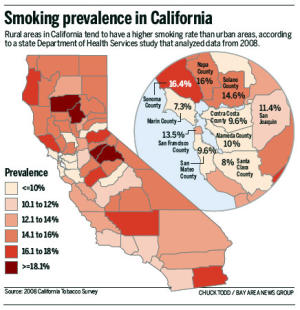Richmond Ordinance 23-09 (Chapter 9.57), which prohibits smoking in and around multi-family residences (premises that contain two or more units) goes into effect on January 1, 2011. The American Lung Association asks, “If banning smoking in workplaces and public places reduces asthma hospitalizations for children by 18%, what will smoke-free housing do?”
Smoke-Free Laws May Help Kids Breathe Easier
Scottish study showed 18 percent annual decline in childhood asthma hospitalizations
By Kathleen Doheny
HealthDay Reporter
WEDNESDAY, Sept. 15 (HealthDay News) -- Laws that ban smoking in workplaces and public settings seem to show a fringe benefit: Scottish researchers report that such legislation is linked with a decline in hospital admissions for childhood asthma.
Researchers have long known that exposure to tobacco smoke increases the incidence and severity of asthma, and that children are especially vulnerable.
While other studies have looked at the effects of smoking bans on all ages, and have taken into account on-the-job exposure, "ours is the first study to have looked at a subgroup of the population [children], who do not have occupational exposure," said lead researcher Dr. Jill Pell, the Henry Mechan Professor of Public Health at the University of Glasgow.
Full article: http://consumer.healthday.com/Article.asp?AID=643170
Serena Chen
Policy Director
American Lung Association in California
424 Pendleton Way
Oakland, CA 94621
Telephone (510) 638-5864, ext. 303
Fax: (510) 638-8984
www.californialung.org

East Bay smoking rates among lowest in state
By Matthias Gafni
Contra Costa Times
Posted: 12/20/2010 03:51:04 PM PST
Updated: 12/21/2010 08:02:55 AM PST
Related Documents
Related
About one in every 10 Contra Costa and Alameda county residents smokes, among the lowest rates in the state, according to the county-by-county report released Monday, the most detailed ever.
Contra Costa tied with San Mateo County for the sixth lowest in the state -- 9.6 percent -- and Alameda ranked eighth at 10 percent, according to the state Department of Health study examining 2008 data. The statewide rate is the lowest ever at 13.1 percent, with nearly 4 million Californians smoking.
About 21 percent of Americans smoke, according to the Centers for Disease Control and Prevention.
"The really good news is California and Contra Costa have made huge successes and gains in reducing smoking rates," said Denice Dennis, Contra Costa tobacco prevention project manager. "We've had lots of gains through the adoption of smoking prevention policies."
Contra Costa County and its cities have passed strict secondhand smoke policies and cracked down on the illegal sales of tobacco to minors, she said. Still, the most recent Healthy Kids survey found that 11th-graders in Contra Costa self-reported a smoking rate of 15 percent.
While happy with the numbers, Alameda County's tobacco control program director has some reservations about the phone survey, which called landlines only.
"The younger populations are more mobile and may have been unintentionally excluded from the survey," Paul Cummings said. He also wished the survey had county-by-county demographic data.
Previously, East Bay advocates have relied on less thorough state surveys of smoking rate estimates. The last report, in 2005, found Contra Costa with a 12.4 percent smoking rate and Alameda County at 11 percent.
The low East Bay rates are not surprising, said California's public health director.
"Smoking prevalence tends to be higher in rural counties than urban counties," Dr. Mark Horton said.
The state hopes to investigate why rural counties average 15.9 percent versus 10.9 percent in urban counties, he said.
Urban would-be and active smokers are saturated with social behavior strategies that, like peer pressure, make smoking unattractive, Cummings said.
"In rural areas, if you're addicted to smoking, you're not getting those daily messages," he said.
Almost as encouraging as the lower state smoking rate, second only to Utah, Horton said, was the increase in attempts to quit. In 2009, 60 percent of smokers made a recent quit attempt, and 76 percent of young adults (those ages 18 to 24) tried to stop, according to the report.
The most effective strategy to increase smoking cessation is further taxing tobacco, Cummings said.
"If the tobacco tax increased by a significant amount, it would make a lot of people question why they should continue smoking and try harder to quit," he said.
California charges 87 cents per pack, the country's 30th highest tax.
The report also provided statewide smoking demographics.
Although declining, the smoking rate among blacks in 2008 was above the state average at 14.2 percent, the highest age group being the 20 percent of 45- to 65-year-olds who smoke.
Cummings hopes the East Bay can lobby the Federal Drug Administration to ban menthol cigarettes, which target young smokers and black neighborhoods.
"It masks the harsh taste and it's easier for younger people to get addicted," he said. "It's a social justice

Click on image to enlarge
issue."
The FDA recently banned flavored cigarettes.
Some other report findings:
· Men still smoke at higher rates than women, 15.6 percent versus 10.7 percent, according to 2009 data.
· The college graduate smoking rate was 5.9 percent in 2008, compared to 12 to 15 percent for those with lesser educations.
· In 2008, households with an income of more than $150,000 had a 7.8 ercent smoking rate, compared to a 19.8 percent rate for those making less than $20,000.
· The Asian smoking rate in 2008 dropped to 8.1 percent, and the Latino rate dropped to 10.2 percent.
· Americans smoke more than 360 billion cigarettes annually in America, leading to 135 million pounds of discarded butts. The toxic filters represent 28 percent of total litter collected worldwide, the most prevalent item identified.
Contact Matthias Gafni at 925-952-5026.
smoking study
To read the full state department of health report on tobacco use behaviors by rural/urban areas, ethnicity and environment, go to www.contracostatimes.com.
lowest smoking rates
County Rate
· Marin 7.3
· Yolo 7.7
· Santa Clara 8
· Madera, Placer 9.5
· Contra Costa, San Mateo 9.6
· Alameda 10 percent
Source: State Department of Health

